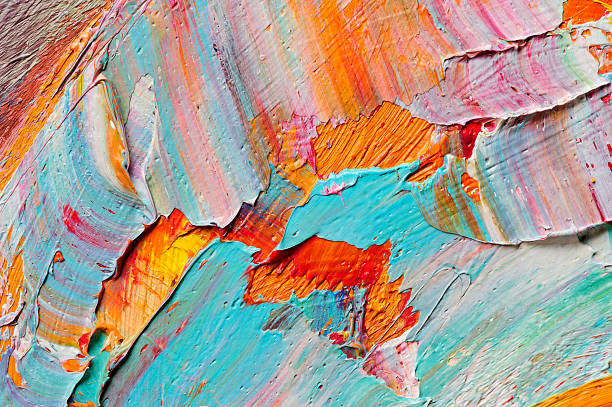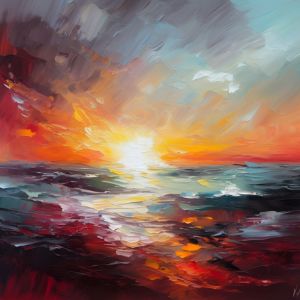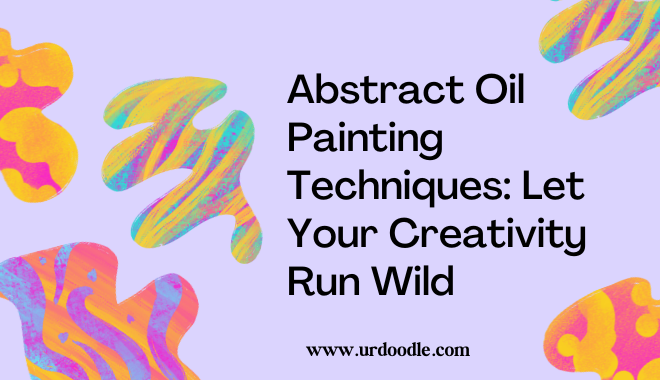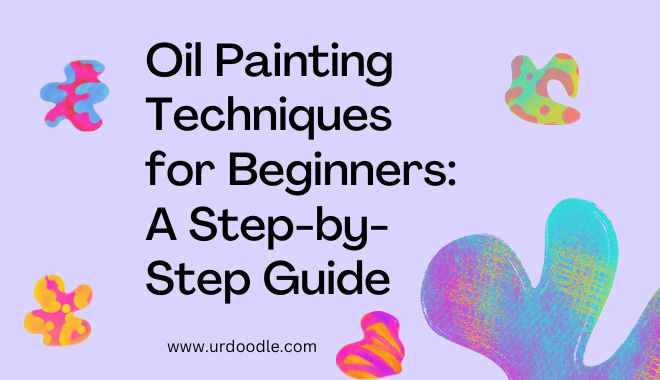If you’re diving into the world of abstract oil painting, congratulations! You’ve just unlocked a playground where rules are meant to be broken, and your imagination gets to steal the spotlight. Abstract oil painting is all about expressing emotions, ideas, and vibes without sticking to realism. Don’t worry if it feels intimidating at first. With a little guidance, you’ll be splashing paint like a pro in no time.
Here’s a breakdown of some epic techniques and tips to get you started. By the end of this guide, you’ll feel ready to tackle that canvas and create your masterpiece.

1. The Magic of Layers
Abstract oil painting thrives on texture and depth. Layers are your best friend. Start by laying down a base layer of colors or shapes to set the tone for your painting. This could be as simple as broad strokes of your favorite hues or even a messy splatter.
- Pro Tip: Use a palette knife or a sponge for your first layer. They create rough, uneven textures that make your painting more dynamic.
- Why It Works: Layers add visual interest. People can’t help but get lost in the complexity of overlapping shapes and shades.
Let each layer dry before adding the next, or if you’re feeling adventurous, experiment with wet-on-wet techniques for unexpected blends.
2. Play with Color Contrasts

Color is king in abstract art. Don’t overthink it—just grab colors that speak to you. Want a bold and dramatic vibe? Pair complementary colors like blue and orange. Feeling calm and serene? Stick with analogous shades like blue, green, and turquoise.
- Hot Tip: Use a limited color palette. Too many colors can overwhelm your piece and confuse the eye.
- Experiment: Try blending colors directly on the canvas to create soft transitions, or keep them sharp for a punchy effect.
3. Textures: Go Big or Go Home
One of the coolest things about oil paint is how thick and buttery it is. Take full advantage of that! Don’t just stick to smooth strokes—get messy with your tools.
Here are some ways to experiment with texture:
- Palette Knife: Drag it across your canvas for bold, uneven strokes.
- Bristle Brushes: Great for creating scratchy, gritty textures.
- Household Items: Bubble wrap, sponges, or even an old toothbrush can add unique effects.
- Impasto Technique: Lay the paint on thick, like frosting a cake. It adds dimension and drama to your work.
4. Go Beyond the Brush
Who says you need to stick to traditional tools? Abstract painting is all about breaking the rules. Use your fingers, sponges, or even random objects around the house.
- Forks and Combs: Drag these through wet paint for funky patterns.
- Credit Cards: Scrape paint across the canvas to create clean lines or jagged edges.
- Spray Bottles: Fill one with a thin oil paint mixture and spray it for a wild splatter effect.
5. Embrace Chaos with the Drip Technique
This is one of the most fun (and messy) techniques out there. Dripping paint on your canvas gives you an unpredictable yet striking effect. Thin your oil paint with a medium like linseed oil or turpentine, then let it drip freely.
- Best Practice: Tilt your canvas in different directions to control the flow.
- Pro Move: Layer drips over bold strokes for an energetic vibe.
6. Blend, Don’t Blend: Know When to Stop
Blending is tempting because oil paints are so easy to manipulate. But overdoing it can muddy your colors. Strike a balance by blending selectively. Leave some hard edges for contrast while smoothing out other areas.
- Tip: Use a soft brush or even your finger for subtle blending.
- Pro Tip: If you accidentally overblend, wait for the area to dry and paint over it with fresh, bold strokes.
7. Experiment with Shapes and Lines
Abstract painting isn’t just about colors. Shapes and lines play a huge role in creating movement and emotion.
- Geometric Shapes: Circles, squares, and triangles can create structure.
- Organic Lines: Loose, curvy lines make your painting feel fluid and natural.
- Overlapping: Stack shapes on top of each other to create a sense of depth.
8. Negative Space is Your Friend
You don’t have to fill every inch of your canvas. Leaving some areas blank or less detailed creates balance and allows the viewer’s eye to rest.
- Hot Tip: Use white or neutral colors for negative space. It gives your bold areas more impact.
- Why It Works: Negative space highlights your focal points and prevents your painting from feeling chaotic.
9. Let Your Emotions Take Over
Abstract painting is personal. Let your emotions guide your strokes. Feeling angry? Use sharp, jagged lines and dark colors. Feeling happy? Go for soft, flowing shapes and bright tones.
- No Right or Wrong: Don’t judge yourself. Let your instincts take control, and you’ll end up with something uniquely you.
- Meditative Approach: Put on your favorite music and let it influence your strokes. You might be surprised by the results.
10. Use Glazing for Subtle Depth
Glazing is a technique where you apply thin, transparent layers of paint over dried sections. This creates a luminous effect and adds depth.
- How-To: Mix your oil paint with a glazing medium to make it more transparent. Apply lightly with a soft brush.
- Why It’s Cool: Glazing can make colors appear to glow, perfect for adding highlights or soft transitions.
11. Scratch It Up
Once your painting has dried a bit, scratch into it with a palette knife, fork, or even your fingernails. This technique, known as sgraffito, reveals the layers underneath.
- Why It Rocks: It adds texture and intrigue, making people want to get up close and inspect your work.
- Tip: Use this sparingly to avoid overwhelming your piece.
12. Step Back and Reflect
It’s easy to get lost in the details, but don’t forget to step back and look at your painting as a whole. This helps you spot areas that need more balance or contrast.
- Pro Move: Take a photo of your painting and look at it on your phone. Sometimes a smaller view helps you see the big picture.
13. Keep the Vibes Loose
Don’t aim for perfection. Abstract art isn’t about making something “right.” It’s about capturing energy and emotion. If you mess up, embrace it and make it part of the painting.
14. Know Your Drying Times
Oil paints take time to dry—sometimes days or weeks. This can be both a blessing and a curse. Use the slow drying time to your advantage by blending and reworking areas until you’re happy.
- Layering Tip: Paint “fat over lean” (thicker, oilier layers over thinner ones). This prevents cracking as your painting dries.
- Patience Pays: Resist the urge to overwork areas while they’re still drying. Sometimes leaving it alone results in unexpected beauty.
15. Experiment with Mediums
Oil painting mediums can completely change the texture and finish of your work.
- Linseed Oil: Makes paint smoother and slower to dry.
- Liquin: Speeds up drying time and adds a glossy finish.
- Turpentine: Thins paint for drips or washes but use it sparingly—it’s strong stuff.
- Beeswax Medium: Adds a creamy texture and makes your paint super thick.
Test different mediums to see which ones fit your style best.
16. Add a Touch of Metallics
Want to add a bit of shine to your abstract painting? Incorporate metallic oil paints like gold, silver, or bronze. A little goes a long way and can create stunning highlights or focal points.
- Where to Use: Apply metallics sparingly in areas where you want to draw attention. They pop beautifully against matte textures.
17. Incorporate Mixed Media
Who says you have to stick to just oil paints? Mix in other materials like charcoal, pastel, or even collage elements. Abstract art is about pushing boundaries, so don’t be afraid to experiment.
- Collage Elements: Use torn paper, fabric, or even photos for added texture.
- Charcoal Lines: Add dynamic black lines to your painting for contrast and structure.
18. Rotate Your Canvas
Sometimes, flipping your canvas upside down (or sideways) can give you a fresh perspective. This trick works wonders when you’re stuck or unsure how to proceed.
- Why It Helps: It takes your focus off specific areas and helps you see the composition as a whole.
- Pro Tip: Don’t be afraid to paint with the canvas on the floor for more freedom of movement.
19. Create a Series
Instead of focusing all your energy on a single painting, try creating a series. Pick a theme—like a specific color palette, emotion, or shape—and explore it across multiple canvases.
- Why It’s Fun: A series helps you dig deeper into your ideas and often leads to surprising discoveries.
- Display Idea: A cohesive series looks fantastic when hung together as a set.
20. Trust the Process
Abstract oil painting is as much about the journey as it is about the final result. Don’t stress if your work doesn’t look like you imagined. Often, the best pieces come from happy accidents and spontaneous decisions.
- Mindset Shift: Treat each painting as an experiment. There’s no pressure to “finish” it perfectly.
- Embrace Growth: Each painting teaches you something new, so don’t compare yourself to others or expect perfection right away.
Common Abstract Painting Challenges (and How to Beat Them)
1. “My painting looks like a mess!”
That’s okay! Abstract art often goes through an “ugly stage.” Keep working on it, adding layers and refining areas. Trust your instincts and step back often to see the bigger picture.
2. “I don’t know where to start.”
Start with a single color or shape. Once you’ve got something on the canvas, it’s easier to build on it. Remember, there’s no “wrong” way to begin.
3. “I’m scared to ruin it.”
You can’t ruin abstract art! If something doesn’t work, let it dry and paint over it. Some of the best effects come from layering mistakes into masterpieces.
Wrapping It All Up
Abstract oil painting isn’t about creating something that everyone else will understand—it’s about expressing yourself and letting your creativity flow. Whether you’re splashing paint, layering textures, or experimenting with wild tools, the key is to enjoy the process.
Take a step back, admire your work, and celebrate your progress. Every brushstroke is a step closer to discovering your unique artistic voice. Now, grab that canvas, throw on your favorite playlist, and get painting! The abstract art world is waiting for your magic.
Abstract oil painting is all about freedom. There’s no pressure to make something look “real.” Instead, focus on playing with colors, textures, and techniques that feel right to you. Let the canvas be your playground, and remember—there are no mistakes in abstract art, just happy accidents. So grab your brushes (or your forks), and start creating! Your masterpiece is waiting.



